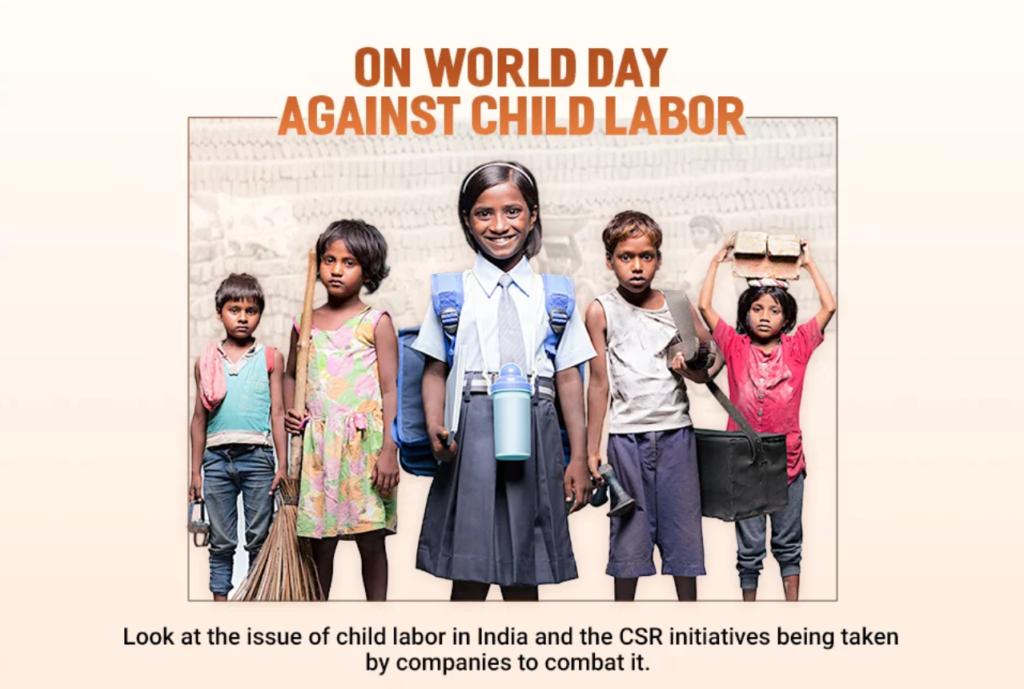June 12 is observed as the World Day against Child Labor every year. This day serves as an opportunity to raise awareness about the pressing issue of child labor and the growing need to put an end to it.
Child labor is a serious problem affecting millions of children worldwide. An estimated 160 million children between the ages of 5 and 17 are victims of child labor. Developing countries account for the majority of child laborers, with Africa and Asia alone encompassing approximately 90% of all child labor cases.
There are many reasons why children are forced to work. Some children work because their families are poor and need extra income. Others work because they have been trafficked or forced into slavery. Child labor has several negative consequences. It can harm children’s health, education, and development. It can also lead to exploitation, abuse, and violence.
Several things have been done to combat child labor; Governments have passed laws to protect children from exploitation. Whereas, businesses have adopted policies prohibiting child labor in their supply chains. And communities have worked together to provide education and other opportunities for children so they do not have to work.
India’s federal form of government means that different states have different laws on child labor. The Factories Act of 1948 prohibits the employment of children below 14 years of age in any factory. While the Child Labor Prohibition and Regulation Act of 1986 echoes this prohibition. Child labor is considered a criminal offense in India, and various organizations have turned to CSR to address this issue.
There are estimated 12.2 million children between the ages of 5 and 17 in India who were in child labor in 2023. Most child laborers in India are engaged in agriculture, followed by manufacturing and construction. Children in these sectors are often exposed to dangerous working conditions. Such as exposure to pesticides, long hours of work, and physical and verbal abuse.
Several factors contribute to child labor in India, including poverty, lack of access to education, and social norms that view child labor as acceptable. Indian companies have taken many CSR initiatives to combat child labor. Some of these initiatives include:
- Providing education and training to children from low-income families.
- Creating jobs for adults so that children do not have to work.
- Working with communities to raise awareness about the dangers of child labor.
- Supporting organizations that are working to combat child labor.
These initiatives are making a difference. The number of children in child labor in India has declined recently. However, there is still much work to be done. On World Day against Child Labor, let’s recommit ourselves to the fight to end child labor.
Here are some examples of CSR initiatives taken by Indian companies to combat child labor:
- Tata Trusts: Tata Trusts is a philanthropic organization working to eradicate child labor in India for many years. They have several initiatives in place, including providing education and vocational training to children, supporting families of child laborers, and working to change social attitudes toward child labor.
- HUL Foundation: HUL Foundation is the philanthropic arm of Hindustan Unilever, India’s leading consumer goods company. They have several initiatives to combat child labor, including providing education and vocational training to children, supporting families of child laborers, and working to change social attitudes toward child labor.
These are just a few examples of the many CSR initiatives that Indian companies are taking to combat child labor. These initiatives are making a difference and helping to create a better future for children in India.
On World Day against Child Labor, we must remember that the battle to end this harmful practice is far from over. However, the CSR initiatives taken by Indian companies offer a beacon of hope. By investing in education, collaborating with NGOs, generating livelihoods, and raising awareness, these companies contribute significantly to eradicating child labor in India. As we move forward, more companies must follow suit and take up the mantle of social responsibility to create a better world for our children. The fight against child labor requires a collective effort from governments, businesses, communities, and individuals. While progress has been made, much work must be done to ensure that every child can receive an education and live a life free from exploitation and abuse. Let us continue to raise awareness and take action to end child labor, not just on World Day against Child Labor, but every day.
Article Credits: Cross Barriers

Pingback: A Pune startup’s eco-friendly device promises to help eliminate mosquito menace - SLSV - A global media & CSR consultancy network
Pingback: Empowering Communities through Impact-Driven CSR Initiatives - SLSV - A global media & CSR consultancy network
Pingback: CBRE, Save the Children partner to support 3 lakh labourers in accessing quality health, education, food - SLSV - A global media & CSR consultancy network